Introduction
Here are some examples of exercises for you to try. The exercises may be suggested for a condition or for rehabilitation. Start each exercise slowly. Ease off the exercises if you start to have pain.
You will be told when to start these exercises and which ones will work best for you.
How to do the exercises
Pelvic tilt with marching
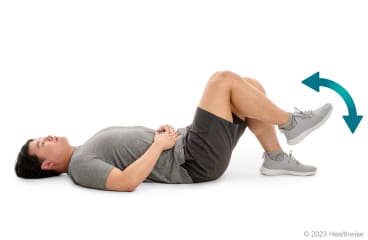
slide 1 of 6
slide 1 of 6, Pelvic tilt with marching,
- Lie on your back on the floor, with your knees bent and your feet flat on the floor. (Or you can lie on any flat surface, such as a bed.)
- Tighten your belly muscles by pulling your belly button in toward your spine. Press your lower back to the floor. You should feel your hips and pelvis rock back. Try to keep the belly muscles tight while you do the exercise.
- Slowly lift and lower one foot at a time, like you are marching.
- Continue until you have done this 8 to 12 times with each foot.
Scissors
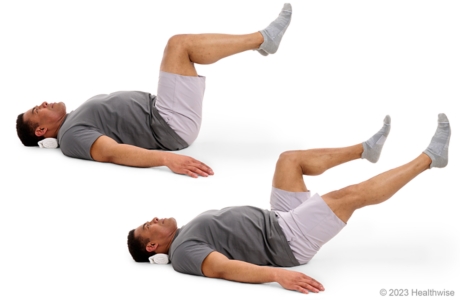
slide 2 of 6
slide 2 of 6, Scissors,
- Lie on your back with your knees bent at a 90-degree angle and your feet off the floor.
- Tighten your belly muscles and buttocks, and press your lower back to the floor. Keep breathing normally and don't hold your breath.
- Slowly straighten one leg, and hold that position for about 6 seconds. Your leg should be about 12 inches off the floor. Bring that leg back to the starting position, and then straighten your other leg. Hold that position for about 6 seconds, and then switch legs again.
- Repeat 8 to 12 times with each leg.
Hamstring stretch (lying down)
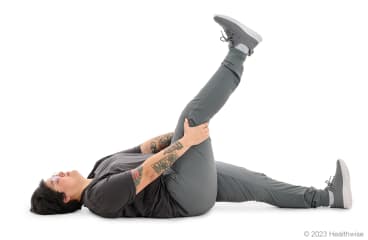
slide 3 of 6
slide 3 of 6, Hamstring stretch (lying down),
- Lie flat on your back with your legs straight. If you feel discomfort in your back, place a small towel roll under your lower back.
- Holding the back of your affected leg, lift your leg straight up and toward your body until you feel a stretch at the back of your thigh.
- Hold the stretch for at least 15 to 30 seconds.
- Repeat 2 to 4 times.
- It's a good idea to repeat these steps with your other leg.
Quad stretch (lying on side)
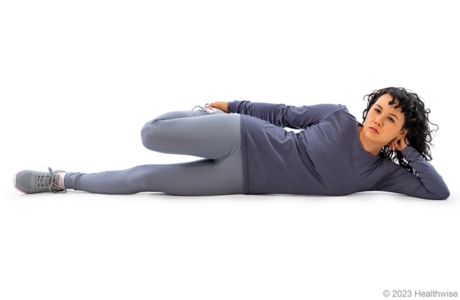
slide 4 of 6
slide 4 of 6, Quad stretch (lying on side),
- Lie on your side with your affected leg on top. You can use your hand or a pillow to support your head.
- Bend your top leg, and reach behind you to grab the front of that foot or ankle with your other hand.
- Stretch your leg back by pulling your foot toward your buttock. You will feel the stretch in the front of your thigh.
- Hold the stretch for at least 15 to 30 seconds.
- Repeat 2 to 4 times.
- It's a good idea to repeat these steps with your other leg.
Hip flexor stretch (kneeling)
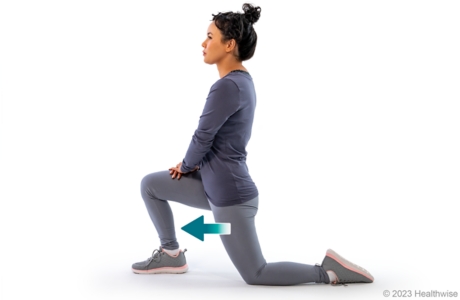
slide 5 of 6
slide 5 of 6, Hip flexor stretch (kneeling),
- Kneel on your affected leg and bend your other leg out in front of you, with that foot flat on the floor. If you feel discomfort in the front of your knee, place a towel under your knee.
- Keeping your back straight, slowly push your hips forward. You should feel a stretch in the upper thigh of your back leg and hip.
- Hold the stretch for at least 15 to 30 seconds.
- Repeat 2 to 4 times.
- It's a good idea to repeat these steps with your other leg.
Hip flexor stretch (edge of table)
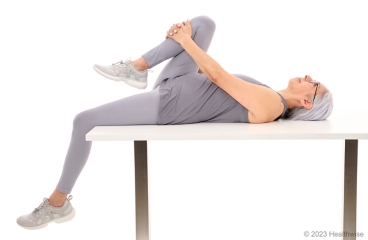
slide 6 of 6
slide 6 of 6, Hip flexor stretch (edge of table),
- Lie on your back on a table or flat bench, with your knees and lower legs hanging off the edge of the table.
- Grab your good leg at the knee, and pull that knee back toward your chest. Relax your affected leg and let it hang down toward the floor until you feel a stretch in the upper thigh of your affected leg and hip.
- Hold the stretch for at least 15 to 30 seconds.
- Repeat 2 to 4 times.
- It's a good idea to repeat these steps with your other leg.
Current as of: July 17, 2023
Author: Healthwise Staff
Clinical Review Board
All Healthwise education is reviewed by a team that includes physicians, nurses, advanced practitioners, registered dieticians, and other healthcare professionals.

